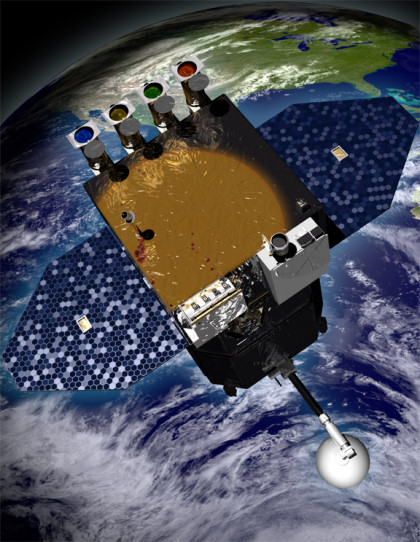Press Release 02/2010 - February 4, 2010
A step towards predicting space weather
The Max Planck Institute for Solar System Research is partner of the NASA mission "Solar Dynamics Observatory" that starts on February 9th.
NASA’s space probe Solar Dynamics Observatory is scheduled to lift off on Tuesday, February 9th. During the next years, three instruments on board will deliver precise images of the Sun every ten seconds. This will make it possible to track the magnetic processes within our star and predict the solar activity. Data centres worldwide will process and archive the huge amounts of data of around 1.5 terabyte (this corresponds to approximately 240 Hollywood movies) per day. The only German data centre is located at the Max Planck Institute for Solar System Research in Katlenburg-Lindau, Germany. The institute will therefore not only become part of the mission’s memory. Scientists will also compile precise maps of the Sun.
The Sun changes constantly. Huge flows of plasma within its hot interior keep the magnetic fields in the outside layers in constant motion. This complicated interplay is the key to an understanding of many phenomena that characterize our star - for example the dark sunspots. The magnetic field is also closely connected to the violent eruptions of radiation and charged particles into space. Predicting this so-called space weather is the goal of many scientists. It would enable the operators of navigational and communication satellites to switch their instruments into a safe-mode or astronauts to seek protection in special shelters on their space stations.
Until now one of the most important requirements for such a weather forecast was missing: an efficient data stream from the Sun. Older space probes like  SOHO which has been orbiting the Sun since 1995 allow only for a much slower transfer rate - and deliver images with a much poorer resolution. SDO however, with its modern instruments and distance of only 36 000 kilometres above the Earth’s surface can transfer up to 300 Megabit per second. Together with data obtained by the solar space probe
SOHO which has been orbiting the Sun since 1995 allow only for a much slower transfer rate - and deliver images with a much poorer resolution. SDO however, with its modern instruments and distance of only 36 000 kilometres above the Earth’s surface can transfer up to 300 Megabit per second. Together with data obtained by the solar space probe  STEREO scientists will be able to monitor the entire space between the Sun and Earth: While SDO can discern first signs of solar eruptions, STEREO can watch the ejected material on its way toward Earth.
STEREO scientists will be able to monitor the entire space between the Sun and Earth: While SDO can discern first signs of solar eruptions, STEREO can watch the ejected material on its way toward Earth.

|
From a height of 36 000 kilometers SDO transfers data from the Sun down to Earth.
|
(Credit: NASA)
|
SDO will study the Sun using three instruments. The Helioseismic and Magnetic Imager (HMI) provides information from the interior of the star with the help of "sunquakes". Just like earthquakes allow conclusions about the interior structure of our planet, the acoustic waves at the Sun’s surface show processes deep within. At the same time, the Atmospheric Imaging Assembly (AIA) studies the Sun’s atmosphere allowing researches to study the connection between processes within and at the surface. As partners of NASA MPS-scientists will help analyze the data from these two instruments. The third instrument on board, the EUV Variability Experiment, measures how the intensity of the extreme UV-radiation emitted by the Sun changes in time.
All in all, SDO gathers an enormous amount of data: Every day it will send 1.5 terabyte back to Earth. This can be compared to a daily download of 500 000 songs or 240 Hollywood movies. In order to handle this flood of information, the ground station in White Sands (New Mexico, USA) distributes the data to the mission’s data centres - for example to MPS. There scientists will create high precision maps of the flows within the Sun, three dimensional maps of the magnetic fields in the Sun’s atmosphere and charts of the current solar brightness.
The SDO-mission costs approximately 870 million US-Dollars. The German Aerospace Centre and the German Ministry for Economy and Technology support the activities at MPS. In Germany also the Astrophysical Institute in Potsdam and the Kiepenheuer Institute for Solar Physics in Freiburg are participating in the scientific work.
Contact
Dr. Birgit Krummheuer
Press and Public Relations
Max Planck Institute for Solar System Research
Max-Planck-Straße 2
37191 Katlenburg-Lindau
Tel.: +49 5556 979 462 u. +49 551 5176 668
Email: krummheuer mps.mpg.de
mps.mpg.de
Prof. Dr. Laurent Gizon
Max Planck Institute for Solar System Research
Max-Planck-Straße 2
37191 Katlenburg-Lindau
Tel: +49 5556 979 439 u. +49 551 39 5058
Email: gizon mps.mpg.de
mps.mpg.de
Prof. Dr. Sami K. Solanki
Max Planck Institute for Solar System Research
Max-Planck-Straße 2
37191 Katlenburg-Lindau
Tel: +49 5556 979 552
Email: solanki mps.mpg.de
mps.mpg.de
